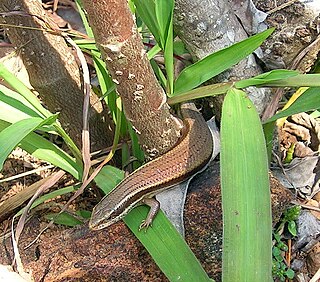
Skinks are lizards belonging to the family Scincidae, a family in the infraorder Scincomorpha. With more than 1,500 described species across 100 different taxonomic genera, the family Scincidae is one of the most diverse families of lizards. Skinks are characterized by their smaller legs in comparison to typical lizards and are found in different habitats except arctic and subarctic regions.

Menetia is a genus of skinks, lizards in the family Scincidae. The member species of the genus Menetia are endemic to Australia. They are ground-dwellers and live in open forests and open grasslands.

Cullen skink is a thick Scottish soup made of smoked haddock, potatoes, and onions. An authentic Cullen skink will use finnan haddie, but it may be prepared with any other undyed smoked haddock. Sometimes ocean perch or salmon are used in the soup.

The river cooter is a species of freshwater turtle in the family Emydidae. The species is native to the central and eastern United States, but has been introduced into parts of California, Washington, and British Columbia.

The nabarlek is a small species of macropod found in northern Australia. They are a shy and nocturnal animal that resides in rocky hollows and forages in the surrounding area. Their diet is grasses, sedges, and ferns found in and around their scrub covered refuges. They are distinguished by a reddish tinge to the mostly grey fur and a distinct stripe at the cheek. They move with great speed and agility when observed, with a forward leaning posture and a bushy tail that arches over the back.

The eastern river cooter is a subspecies of turtle native to the eastern United States, with a smaller population in the midwest. It is found in freshwater habitats such as rivers, lakes, and ponds.

Lygosominae is the largest subfamily of skinks in the family Scincidae. The subfamily can be divided into a number of genus groups. If the rarely used taxonomic rank of infrafamily is employed, the genus groups would be designated as such, but such a move would require a formal description according to the ICZN standards.

Menetia greyii, commonly known as the common dwarf skink or Grey's skink, is a species of lizard in the family Scincidae. The species is native to mainland Australia and Indonesia.

Morethia boulengeri is a species of lizard in the family Scincidae. The species is endemic to Australia.

Greenly Island is an island in the Australian state of South Australia located in the Great Australian Bight about 30 kilometres (19 mi) west-south-west of Point Whidbey on Eyre Peninsula. The island is uninhabited by humans and provides a haven for marine and terrestrial wildlife. The island and its intertidal zone constitute the Greenly Island Conservation Park. Its adjacent waters are occasionally visited by fishermen targeting yellowtail kingfish.
Pygmaeascincus is a genus of skinks, lizards in the family Scincidae. All member species are endemic to Australia.

Eugongylinae is a subfamily of skinks within the family Scincidae. The genera in this subfamily were previously found to belong the Eugongylus group in the large subfamily Lygosominae.
Menetia alanae, also known commonly as Alana's menetia and the Top End dwarf skink, is a species of lizard in the family Scincidae. The species is endemic to Australia.
Menetia maini, the northern dwarf skink, is a species of skink found in Northern Territory, Queensland, and Western Australia in Australia.
There are two species of skink named Northern dwarf skink:
Menetia surda, the western dwarf skink, is a species of skink found in Western Australia.
Menetia amaura, common dwarf skink, is a species of skink found in Western Australia.










